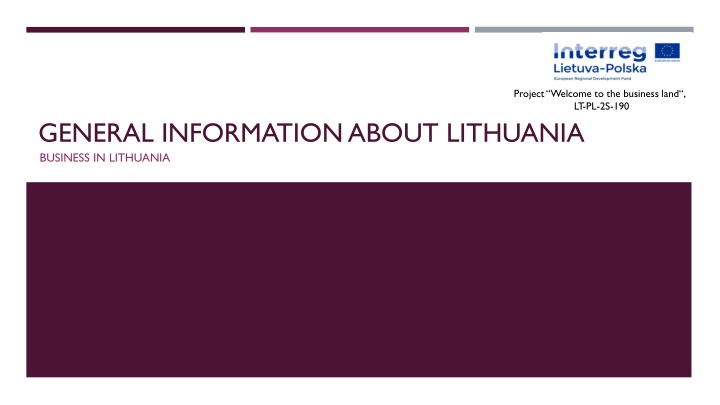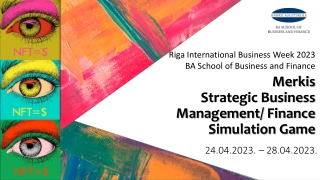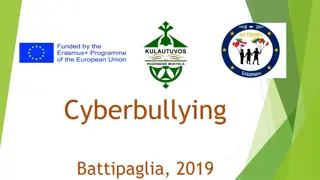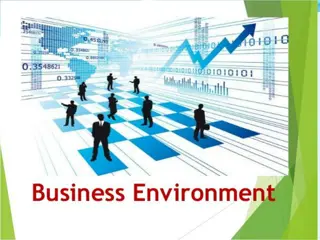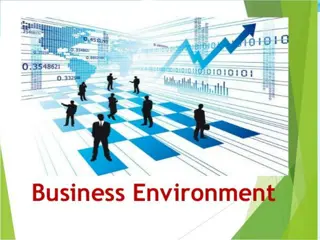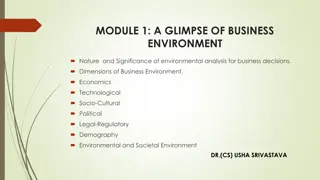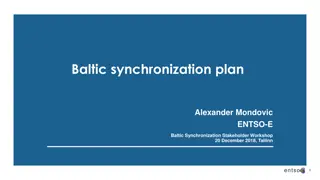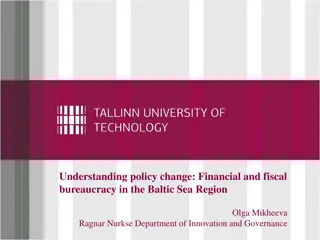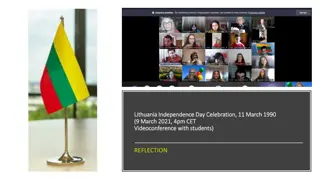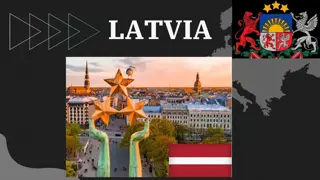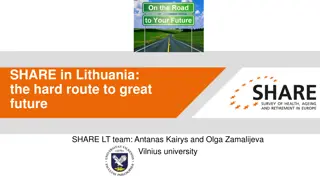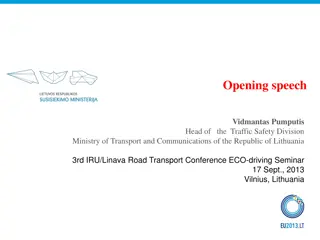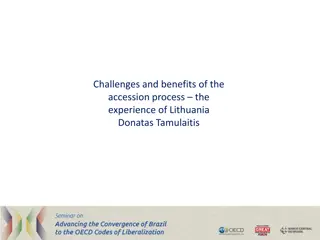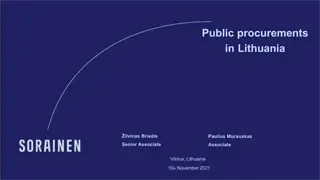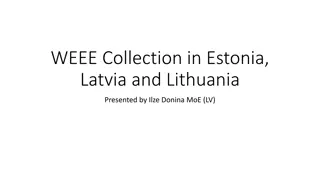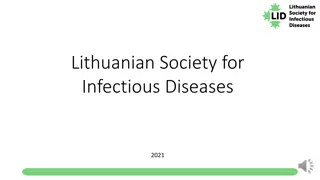Comprehensive Overview of Business Environment in Lithuania
Lithuania, with an area of 650,200 sq. km, is a country rich in history and culture. It is known for its religious population, with around 79% Roman Catholics. The official language is Lithuanian, and the currency is Euro. The political system is a parliamentary democracy, and the country is divided into 10 counties with major cities like Vilnius, Kaunas, and Klaipėda. Lithuania is an active member of international organizations like NATO, the European Union, and the Schengen Area, showcasing its commitment to global cooperation and development.
Download Presentation

Please find below an Image/Link to download the presentation.
The content on the website is provided AS IS for your information and personal use only. It may not be sold, licensed, or shared on other websites without obtaining consent from the author.If you encounter any issues during the download, it is possible that the publisher has removed the file from their server.
You are allowed to download the files provided on this website for personal or commercial use, subject to the condition that they are used lawfully. All files are the property of their respective owners.
The content on the website is provided AS IS for your information and personal use only. It may not be sold, licensed, or shared on other websites without obtaining consent from the author.
E N D
Presentation Transcript
Project Welcome to the business land, LT-PL-2S-190 GENERAL INFORMATION ABOUT LITHUANIA BUSINESS IN LITHUANIA
FACTS ABOUT LITHUANIA Area: 650 200 sq. km. Neighbors: Latvia (land border 588 km, sea border 22 km) Byelorussia (border 677 km) Poland (border 104 km) Russia (Kaliningrad) (land border 255 km, border in Curonian sea 18 km, sea border 22 km)
FACTSABOUT LITHUANIA Language: Official language Lithuanian, which is the member of Baltic language group (other 2 members are Latvian, and dead Prussian language). It is the most archaic language from all the Indo-European languages. Religion: Lithuania is considered to be very religious country: around 79 percent of Lithuanians consider themselves as Roman Catholics. Currency: Euro Political system: Lithuanian Republic is the parliamentary democracy. The head of state is The President. Executive authority is Prime minister and the cabinet, and the legislative power is in the hands of Seimas (the parliament)
ADMINISTRATIVE DIVISION Lithuania is divided in 10 counties, that are subdivided into 60 municipalities governed by mayors which starting from 2015 are directly elected for four-year term. Municipalities are divided into 546 townships. Cities: The biggest cities in Lithuania: Vilnius 541 824 pop. Kaunas 360 637 pop. Klaip da 187 316 pop.
PARTICIPATION IN INTERNATIONAL ORGANIZATIONS Lithuania joined NATO on 29 March 2004. On 1 May 2004, Lithuania became a full member of the European Union, and joined the Schengen Area on 21 December 2007. In June 2015, the Lithuanian delegation received an official invitation to start accession process to the organisation for Economic Cooperation and Development (OECD). The first positive opinion was issued by the OECD Trade Committee on 22 April 2016. The Lithuanian authorities are in process of an intense technical accession, which is expected to be completed during 2018.
COUNTIESACCORDING NUMBER OF RESIDENTS Number of residents 2016 635732 171791 86170 61639 408179 174868 233569 93731 74806 76987 140234 95160 176446 105186 43687 59396 85908 57603 77882 62288 2014 2015 2017 2018 City Countryside City Countryside City Countryside City Countryside City Countryside City Countryside City Countryside City Countryside City Countryside City Countryside 633652 172454 87318 62533 411924 175314 235017 93996 75932 78152 142047 96701 178435 107328 44109 60514 86953 58529 79193 63371 635174 170206 84362 60747 403092 174266 231111 93507 73342 75735 137800 93201 173729 102600 43158 58042 84574 56719 76886 60307 635086 170087 81671 59945 395001 174874 226140 94367 71214 74146 133824 91209 169928 100554 41883 56725 81817 55952 74504 58977 635886 169481 79413 58682 388003 175109 222119 95133 69127 72160 130112 88614 167491 97976 40714 55103 79445 54694 72412 57227 Vilnius county Lithuania s population is currently in losing about 1.5% of its population per year. The country has now reached its lowest population in decades as more people emigrate to west European countries Alytus county decline, Kaunas county Klaip da county Marijampol county Panev ys county wealthier iauliai county Taurag county Tel iai county Utena county
THE STRUCTURE OF RESIDENTSACCORDINGAGE At the beginning of 2018, the number of children (aged 0 14) was 1.3 times lower than that of elderly people (aged 65 and older). The proportion of children in the total resident population made up 15, that of elderly people 19.6 per cent.
INDEX OFAGEING At the beginning of 2018 , the oldest counties were Utena, Alytus and Panev ys counties, where elderly people made up 22.4 23.9 per cent the total resident population of those counties.
INTERNATIONAL IMMIGRATION OF RESIDENTS In 2017, 47.9 thousand residents emigrated from Lithuania (4.8 per cent less than in 2016 m.). The crude emigration rate (the number of emigrants per 1 000 population) stood at 16.9. The highest number of emigrants per 1 000 population was in Marijampol county (21.4), in iauliai and Tel iai counties the crude emigration rate was 20.2. The lowest in Vilnius county (13.8).
ACCESSIBILITY - INFRASTRUCTURE Lithuania is situated at the heart of Europe, thus making it easy and convenient to access other European cities. There are four international airports in Lithuania, which offer direct flights of up to three hours to the main business destinations. The road network of Lithuania is also well developed.Lithuania has more than 71 thousand kilometres of roads whereof 91% are paved roads.
NEW ECONOMIC ENTITIES REGISTERED As of 1 January 2018, there were 104 117 economic entities in operation in Lithuania (46 per cent of all economic entities registered in the Register of Legal Persons). Over the year, the number of economic entities in operation remained almost unchanged. Almost a quarter (23.8 per cent) of economic entities were engaged in wholesale or retail trade, repair of motor vehicles and motorcycles. Over 80 per cent of economic entities in operation had less than 10 employees; such economic entities employed 17.9 per cent of all the persons employed in the country. The average annual income of most of the economic entities operating in the country does not exceed EUR 0.3 million. Meanwhile, economic entities earning more than EUR 40 million a year make up 0.2 per cent. In 2017, 11 345 new economic entities were registered in Lithuania, unregistered 4674.
NUMBER OF BANKRUPTCY PROCESSES COMPLETED Number of bankruptcy processes completed during the corresponding year | number 2013 2014 2015 2016 2017 Republic of Lithuania Vilnius county Bankruptcies in Lithuania increased to 2869 Companies in 2017 from 2203 Companies in 2016. Bankruptcies in Lithuania averaged 1346.71 Companies from 2001 until 2017, reaching an all time high of 2869 Companies in 2017 and a record low of 590 Companies in 2001. 1450 1607 1858 2203 2869 556 634 758 1010 1217 Alytus county 47 51 51 63 85 Kaunas county 262 308 354 378 612 Klaip da county Marijampol county Panev ys county iauliai county 222 235 286 299 372 39 31 39 65 61 90 84 90 105 146 117 132 150 154 205 Taurag county Tel iai county 24 30 33 25 13 32 36 54 72 81 Utena county 61 66 43 32 77
ATTRACTIVE SECTORS Information and communication technology sector is one of the highly prioritised and most promising sectors in Lithuania. Over 31,500 IT professionals in Lithuania are working in this sector. Modern technologies (such as EDGE technology, 4G mobile communications infrastructure and mobile WiMAX 4G Internet), the fastest public Wi-Fi in Europe and the greatest fibre-optic (FFTH) Internet network penetration in Europe all these factors make Lithuania especially attractive for offshore services. Lithuania s engineering industry has been constantly growing and expanding by approximately 15% every year since 2009. This industry is highly competitive in terms of cost and quality and it is well-integrated into the global supply chains. Products developed by the Lithuanian engineers are often adapted by such international companies and organisations as NASA, Boeing, U.S. Army,BMW,Volkswagen,Hitachi,Siemens and Mitsubishi. Biotechnology research takes place in Lithuania, and the developed techniques and products are applied in the fields of medicine, pharmacy, chemistry, agriculture, environment, etc. Lithuania s biotechnology products are recognised worldwide, as 90% of them are exported to over 100 countries. The main export markets include the USA,Japan,Israel,Germany and the United Kingdom.The sector grows on average by 25% annually.
ATTRACTIVE SECTORS Laser technologies: Lithuania accounts for more than half of the global market of picosecond laser speedometers. A world-class quality of laser production has been recognised by nearly 100 countries importing over 90% of the Lithuanian laser production. Such companies and organisations as NATO, Pentagon, Nuclear Research Centre in Israel, Rezerford Laboratories in England, Berkley University, Livermore National Laboratory are the clients of the Lithuanian companies producing lasers. The sector grows on average by more than 10% annually. The Fintech sector falls among the most promising and growing sectors in Lithuania. It is highly supported and promoted by authorities at both national and municipal levels by the introduction of Fintech-friendly regulations, including the regulations on the obtainment of an e-money or payment license that is 2 3 times faster than in other EU jurisdictions. Direct access to SEPA can be gained via a Bank of Lithuania API. It is also possible to issue your own IBANs. Up to 10 Fintech start-ups were established in Vilnius over the last year. Such companies as Barclays,Western Union, deVere Group, Nasdaq,Revel Systems and other have already chosen Lithuania as one of their go-to places to do business. Renewable energy development is becoming increasingly important for Lithuania s export,too.
ECONOMIC SPECIALISATION OFTHE REGIONS (BUSINESS GUIDE LITHUANIA 2018) The Klaip da region is positioning itself as a blue growth region (i.e. the region will be focusing on the long term strategy to support sustainable growth in the marine and maritime sectors), the Marijampol region is ready to work with investors in wood, food and metal industries, Panev ys aims at becoming the hub of robotics, etc.
SOURCES Business guide Lithuania 2018. PricewaterhouseCoopers UAB. Statistics Lithuania. https://www.stat.gov.lt/home Invest Lithuania. https://investlithuania.com/investor-guide/economic-overview/
About the project The project Welcome to the business land (LT-PL-2S-190) is aimed at showing the border region youth that Business can be simple, if you have a good idea, some support from professionals and general knowledge on business processes. During its implementation, it is planned to organize business leader s competition and International Economic Forum and to activate partnership of project beneficiaries and social partners (schools, business companies, professional development centers). This training material has been produced with the financial assistance of the European Union. The contents of this training material are the sole responsibility of PI PVC and Euroregion Niemen Association and can under no circumstances be regarded as reflecting the position of the European Union. Total projects size is 49 973, 25 EUR. Out of them co-funding of European Regional Development Fund is 42 477,25EUR. This project is Partly financed from the European Regional Development Fund Interreg V-A Lithuania-Poland cooperation programme www.bonusLT-PL.eu
